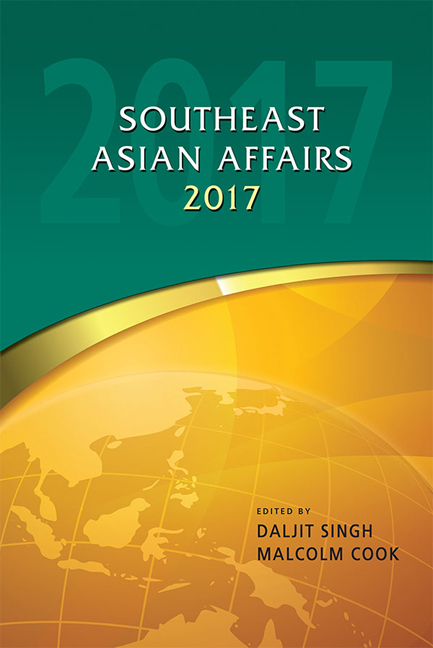Book contents
- Frontmatter
- Contents
- Foreword
- Introduction
- Acknowledgements
- THE REGION
- Southeast Asia in an Age of Strategic Uncertainty: Legal Rulings, Domestic Impulses, and the Ongoing Pursuit of Autonomy
- Southeast Asian Economies: In Search of Sustaining Growth
- Forging the ASEAN Economic Community, 2015 to 2016 — and Beyond
- Southeast Asia's Demographic Situation, Regional Variations, and National Challenges
- U.S.–Japan–Australia Strategic Cooperation in the Trump Era: Moving from Aspiration to Action
- Blurring the Distinction between Huaqiao and Huaren: China's Changing Policy towards the Chinese Overseas
- BRUNEI DARRUSALAM
- CAMBODIA
- INDONESIA
- LAOS
- MALAYSIA
- MYANMAR
- THE PHILIPPINES
- SINGAPORE
- THAILAND
- TIMOR-LESTE
- VIETNAM
Southeast Asia's Demographic Situation, Regional Variations, and National Challenges
from THE REGION
Published online by Cambridge University Press: 12 January 2018
- Frontmatter
- Contents
- Foreword
- Introduction
- Acknowledgements
- THE REGION
- Southeast Asia in an Age of Strategic Uncertainty: Legal Rulings, Domestic Impulses, and the Ongoing Pursuit of Autonomy
- Southeast Asian Economies: In Search of Sustaining Growth
- Forging the ASEAN Economic Community, 2015 to 2016 — and Beyond
- Southeast Asia's Demographic Situation, Regional Variations, and National Challenges
- U.S.–Japan–Australia Strategic Cooperation in the Trump Era: Moving from Aspiration to Action
- Blurring the Distinction between Huaqiao and Huaren: China's Changing Policy towards the Chinese Overseas
- BRUNEI DARRUSALAM
- CAMBODIA
- INDONESIA
- LAOS
- MALAYSIA
- MYANMAR
- THE PHILIPPINES
- SINGAPORE
- THAILAND
- TIMOR-LESTE
- VIETNAM
Summary
This chapter provides an overview of Southeast Asia's demographic situation over the first fifteen years of this century, and highlights variations across countries. It concludes with discussions of major demographic challenges facing each country in the region. Data for this chapter are taken mainly from the United Nations’ World Population Prospects — 2015 Revision database. By focusing on this period, this chapter updates and adds to the findings of an article by Gavin Jones that provides a comprehensive analysis of the population situation for Southeast Asia from 1980 to 2010.
The Socio-economic Context
Demographic changes are closely interrelated with socio-economic development. Hence, a brief overview of the socio-economic conditions in the countries of Southeast Asia will be useful in understanding the variations in demographics across the region. The Human Development Report (HDR) published annually by the United Nations Development Programme provides development indicators for nearly all countries/regions of the world. Some development indicators from the HDR are given in Table 1.
Since 1990 the United Nations has been using the human development index (HDI) to rank countries in terms of human development. HDI is a composite index that combines economic, health, and education indicators. In 2014, Singapore (ranked eleventh in the world) and Brunei Darussalam (at rank thirty-one) were classified as very high HDI countries, Malaysia and Thailand as high HDI countries, Myanmar as a low HDI country, and all the other Southeast Asian nations as medium HDI countries. Between 2000 and 2014, Cambodia, Timor-Leste, Myanmar, and Laos registered the most rapid rise in HDI, each with a gain of between 24 and 32 per cent.
Life expectancy at birth varied within a rather narrow range between 65.9 and 68.9 years in six Southeast Asian countries (Myanmar, Laos, Timor-Leste, the Philippines, Cambodia, and Indonesia), and between 74.4 and 78.8 years in four (Thailand, Malaysia, Vietnam, and Brunei). Singapore has one of the world's highest life expectancies at birth, at 83 years. Within each country, women live longer than men, by between 2.7 (Laos) and 9.5 years (Vietnam).
In 2014 the mean number of years of schooling ranged from 4.1 to 4.4 years in Myanmar and Timor-Leste to 10.0 to 10.6 in Malaysia and Singapore. Data from World Development Indicators show that, between 2000 and 2012, the tertiary enrolment ratio rose markedly for all Southeast Asian countries, except for the Philippines.
- Type
- Chapter
- Information
- Southeast Asian Affairs 2017 , pp. 55 - 82Publisher: ISEAS–Yusof Ishak InstitutePrint publication year: 2017

